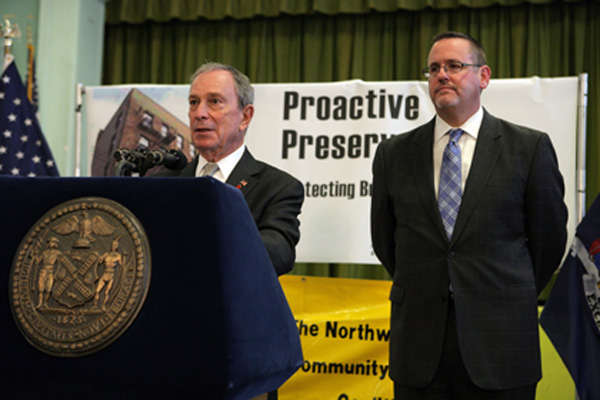
Photo by: City Hall
Mayor Bloomerg and outgoing HPD Commissioner Raphael Cestero, seen last week as they announced a new program to detect problem buildings before tenants are threatened by unsafe conditions.
The commissioner of the Department of Housing Preservation and Development is leaving, Mayor Bloomberg announced Friday, meaning a new housing chief will oversee the final phase of the city’s 11-year affordable housing plan.
Raphael Cestero, who had served as deputy HPD commissioner earlier in the Bloomberg administration before a brief stint in the private sector, took over in February 2009 after Shaun Donovan left to become secretary of the federal Department of Housing and Urban Development.
Cestero will depart on March 31 to become managing director at L+M Development. A spokesman for HPD says Cestero will do no business in New York, focusing on the West Coast, the Gulf Coast and New Jersey.
During Cestero’s time as commissioner, the city’s New Housing Marketplace plan surpassed 100,000 units of new or preserved affordable housing on its way to a goal of 165,000 units by the end of fiscal year 2014.
Faced with rising construction costs for new housing, Cestero oversaw a strategic shift last year toward more preservation and less new construction during the plan’s final years. Instead of 73,000 preservation units, the plan will encompass at least 105,000. And rather than building 92,000 new units, the plan is now targeting about 60,000.
Cestero’s term at HPD also saw increasing concern about the consequences of overleveraged private investment in multi-unit buildings in moderate-income neighborhoods.
As private equity buyers took on mortgages that couldn’t be supported by rent rolls, housing advocates worried that low-income tenants would be uprooted to make way for higher-paying customers, that maintenance would suffer or that buyers would default on their loans, leaving the buildings without accountable ownership.
As one high-profile portfolio in the Bronx fell into foreclosure, upkeep suffered and a “mystery” buyer loomed, HPD used the limited tools at its disposal—ordering repairs, subpoenaing documents and pressuring lenders—to try to improve conditions and encourage a sale to a responsible new buyer.
Last week, HPD announced a new program to detect financial problems at buildings before they impact maintenance, and to get owners to foot more of the bill when the city makes emergency repairs.
In a statement, Mayor Bloomberg said: ““Rafael was instrumental in the development of the New Housing Marketplace Plan and led the launch of the updated plan to keep the City on track to meet the goal of 165,000 affordable housing units by 2014. Under his leadership, the City also launched the most aggressive foreclosure prevention program in the nation, created a $750 million initiative to stabilize distressed multi-family properties, and – as we announced just last week –transformed the process for inspecting and addressing troubled buildings from one that waits for tenant complaints to one that uses data to identify issues proactively.”
“I am grateful to Mayor Bloomberg for having trusted me to lead this extraordinary agency and for his unwavering belief that our best days as a city are still in front of us,” Cestero said. “I am confident we have built a strong foundation from which HPD will continue to protect our City’s tenants and expand and preserve its affordable housing stock for generations to come.”








